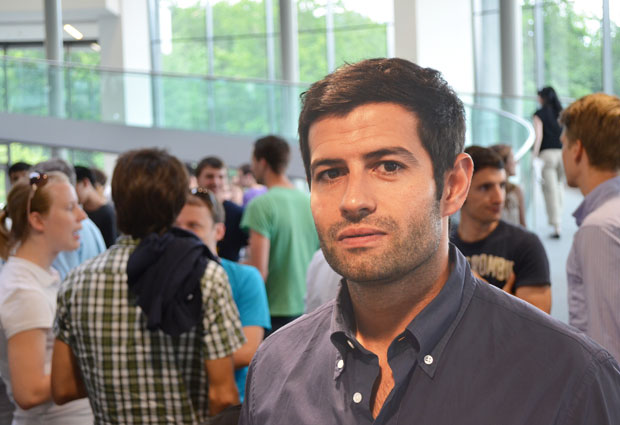
Opinion: A journey from bench to clinical trials
Andrés Palencia on the work done at EMBL to guide the design of compounds that may help to fight drug-resistant TB and other diseases

By Andrés Palencia
Mycobacterium tuberculosis (TB) represents one of the most formidable threats to human health. The bacterium has a hardy outer membrane that protects it from disinfectants and allows it to survive on dry surfaces over long periods. It is also highly infectious: a sneeze from someone infected with TB can release thousands of aerosol droplets containing bacteria, while inhalation of fewer than 10 bacteria is sufficient to cause infection. The high infectivity of TB has been well known for many years and in the past large hospitals were dedicated solely to isolating TB-infected patients. With the discovery of antibiotics for TB the situation improved and many infections could be treated, but the curve of improvement seems to be reversing. Why?
Drug resistance in the post-antibiotic era
In TB, we find not only multi-drug resistance (MDR), but also super-resistance: strains that are extensively drug-resistant (XDR) are not susceptible to first-line of defense drugs (Rifampin and Linezolid) and to at least one of the second-line drugs; strains with totally drug-resistant (TDR) are even more difficult, if not impossible, to treat. With cases of XDR reported in over 100 countries, new drugs are urgently needed.
Motivated by this need, an interdisciplinary project was established, involving scientists from EMBL in Grenoble (Stephen Cusack and myself), Anacor Pharmaceuticals (Palo Alto, USA) and others. Anacor and EMBL had previously worked together on a novel antifungal, now approved by the FDA for the treatment of toe infection (onychomycosis), and on the discovery of Gram-negative antibiotics for the treatment of complicated infections in humans, now in clinical studies. These previous compounds, called benzoxaboroles, shared an original mechanism: the inhibition of leucyl-tRNA synthetase (LeuRS), a protein responsible for charging leucine onto transferRNALeu, as required for protein synthesis.
Based on the known antibacterial activity of some benzoxaboroles, new derivatives were synthesized that showed medium potency against TB. High resolution structural analysis of the TB LeuRS bound to one of these compounds gave us clues, at an atomic level, to design new compounds that showed improved activity. These improved compounds had excellent in vivo results in mice: they cured TB infections with comparable efficacy to Rifampin and Linezolid. As one would expect for a drug with a new mechanism of action, our compound worked equally well against TB clinical isolates resistant to existing drugs.
Benzoxaboroles: one family, many applications
Given the novelty of this inhibition mechanism, we wondered whether the same mechanism could be used to fight other human pathogens, such as Plasmodium, Toxoplasma and Cryptosporidium, for which new medicines also urgently need to be found. Indeed, we went on to show LeuRS inhibitors that are active against these parasites. While the potency of these compounds is not as good as for TB, these results open the way for studies to improve the activity, and hopefully could lead to new anti-parasitic drugs.
Discovering a novel antibiotic for Gram-negative bacteria was an extremely difficult challenge, but to show that these compounds also have therapeutic potential for the treatment of TB, toxoplasmosis or even malaria, proves just how polyvalent they are. Just consider the different properties of the membranes that a compound has to penetrate before acting on the LeuRS target: it is not an easy task!
So, how is it possible that these compounds work so well against such different pathogens? First, their common target is universal: LeuRS provides an essential function for protein synthesis in all living cells. During the last years, Cusack’s group and others have determined the crystal structures of LeuRS from several pathogens, and of the editing domain of the human protein. These revealed structural differences that can be exploited to develop inhibitors specific to a pathogen and that do not act on human protein, thus avoiding dangerous side-effects. Secondly, benzoxaboroles are small in size and easy to modify with different chemical substitutions; they also have good drug-like properties, an overall good oral bioavailability and low toxicity. Together, these properties make them very attractive for drug discovery.
This project has been extremely motivating for me: working with scientists from very different but complementary disciplines has favoured an exchange of ideas that was quite inspiring. Antimicrobial development is a long and very difficult path and tackling the problem from different angles was probably the key to our success. Working in such a big consortium also made possible getting promising compounds from bench to clinical trials relatively short.
It makes me so happy to see our structures guiding the development of new compounds, some of which I hope can become medicines for the treatment of several infectious diseases.
Andrés Palencia now continues this research on anti-parasitic drugs at the Institute for Advanced Biosciences in Grenoble, France.


